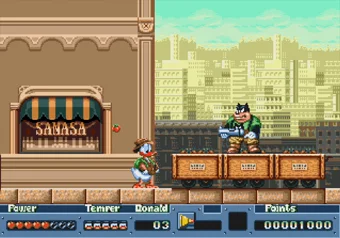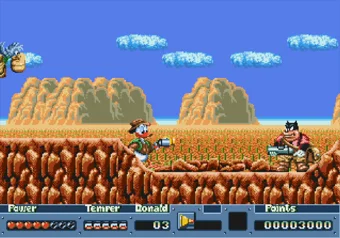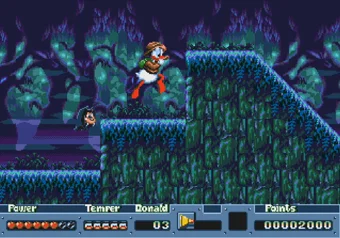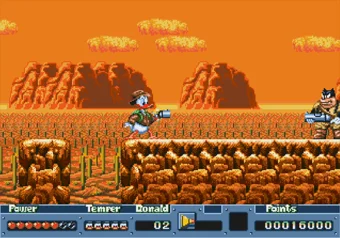🗺 Exploring the First Levels
After a brief introduction in Duckburg, Donald takes off on a globetrotting treasure hunt. Right from the start, players can choose between three destinations: Mexico, Transylvania, and Duckburg itself, which acts as the opening stage. Each location presents unique challenges and visuals, but you won't be able to fully explore them until you've found the right tools. Let's take a closer look at these first three stages.

Duckburg - Where the Journey Begins
The game opens in Duckburg, Donald's hometown, where he finds an old treasure map in Uncle Scrooge's library. This level acts as a tutorial, introducing the basic mechanics: jumping, sliding, climbing, and using the plunger gun to stun enemies and interact with the world. You'll also meet Huey, Dewey, and Louie, who offer hints and context for the journey.
The level is short and straightforward but essential - you'll return here later with new abilities to access previously unreachable areas.

Mexico - Ruins and Puzzles in the Desert
The Mexico stage drops Donald into a sun-drenched desert filled with ancient ruins, stone traps, and aggressive snake enemies. Early on, you can explore only the surface level of the temple complex. It's clear that something lies deeper underground, but blocked paths signal that you'll need an item from elsewhere to go further - like the red plunger upgrade.
The level design teases progression without overwhelming the player. Hidden doors, false walls, and platforming sequences create a satisfying blend of challenge and mystery.

Transylvania - Ghosts, Secrets, and Hidden Doors
Transylvania brings a darker tone with its gloomy castle filled with spooky enemies like ghosts and bats. This stage emphasizes exploration over combat, featuring crumbling platforms, vanishing blocks, and hidden doors that require careful observation.
The eerie music and gothic setting give the level a unique feel early in the game. Just like in Mexico, you'll find yourself blocked partway through and must return later with an item to continue deeper into the castle - part of the game's signature backtracking design.
🧭 A World of Exploration and Backtracking
One of the most interesting things about QuackShot Starring Donald Duck is how it breaks away from the typical level-by-level progression seen in many platformers on the SEGA Genesis/Mega Drive. Right from the start, the game gives you access to a world map, letting you choose between three locations - Duckburg, Mexico, and Transylvania - using Donald's personal airplane. While all three can be visited in any order, some areas require special items, encouraging you to return later and explore further.
This structure turns QuackShot into more than just a side-scrolling platformer. It's a game of exploration, where progress often depends on returning to earlier levels once you've acquired the right tools. For example, you might reach a blocked path in Mexico that you can't get past until you've picked up the red plunger upgrade from another stage. That upgrade allows Donald to stick plungers to walls and use them as temporary platforms - unlocking vertical areas you couldn't reach before.
This design adds a fun layer of puzzle-solving to the experience. You're not just reacting to enemies or jumping across gaps - you're thinking ahead, remembering where you saw blocked doors, unreachable ledges, or suspicious platforms. It gives the game a light Metroidvania flavor, without becoming too complex or confusing.
The world map also encourages experimentation. If you're stuck in one level, you can always try another location and see what you can discover there. Over time, you'll collect keys, gadgets, and abilities that slowly open up the full world. There's even a satisfying sense of "a-ha!" when you realize it's time to fly back to an earlier level and uncover something new.
For younger players or fans of classic Disney games, this approach keeps things engaging without being frustrating. The game gently teaches you to observe, remember, and explore - all while keeping the pace light, fun, and full of personality.
🦆 Fun Facts About QuackShot
🎨 Developed by the Team Behind Castle of Illusion
QuackShot was developed by SEGA's AM7 division - the same team behind Castle of Illusion Starring Mickey Mouse. Both games were part of SEGA's effort to produce high-quality Disney titles for the Genesis/Mega Drive, and they share a similar focus on animation, color, and level variety. The creative leads included director Emiko Yamamoto and composer Shigenori Masuko.
🎬 Inspired by Indiana Jones Adventures
Donald's globe-trotting treasure hunt was heavily inspired by the Indiana Jones films. From his explorer outfit and fedora to the exotic locations like Mexico and Egypt, the parallels are clear. Even the plunger gun - which lets Donald latch onto walls - echoes Indy's whip in spirit. Hidden traps, ancient temples, and lost treasures all add to the cinematic, adventurous feel.
🪠 The Mighty Plunger Gun Has Secrets
Donald doesn't use traditional weapons in QuackShot - instead, he relies on his trusty plunger gun, which gets progressively more useful as the game goes on.
- 🟡 Yellow plungers are the default - they stun enemies temporarily and serve as Donald's basic attack.
- 🔴 Red plungers let Donald stick to certain walls, allowing him to climb upward by creating makeshift ladders.
- 🟢 Green plungers allow Donald to latch onto specific flying enemies or objects, using them to cross wide gaps or reach otherwise inaccessible areas.
Each upgrade isn't just a power-up - it's a tool that unlocks new routes in earlier stages, encouraging exploration and backtracking. These clever mechanics help set QuackShot apart from other platformers of its era.
🇯🇵 The Japanese Title Is Completely Different
In Japan, the game is called I Love Donald Duck: Georgia Ou no Hihou (which roughly translates to The Treasure of King Garuzia). While the title shifts focus to the emotional aspect of Donald's journey, the game content itself is nearly identical to the international version.
🎵 Unique Soundtrack by Shigenori Masuko
The music in QuackShot was composed by Shigenori Masuko, also known for his work on Castle of Illusion. The soundtrack blends catchy platforming tunes with atmospheric regional themes - like mysterious music in Transylvania or adventurous tracks in Mexico. The sound design, though limited by the hardware, helps build personality into each stage.
🗣 Donald Speaks Through Animation
Although QuackShot doesn't include full voice acting, Donald's character shines through his expressive animations and signature "quacking" sound effects. His frustration, excitement, and determination are all clearly visible in his exaggerated gestures - from stomping his feet to making silly faces. It's a great example of how to animate personality without dialogue.
